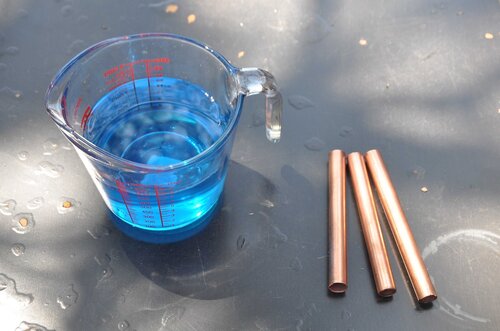A small review of the previous post :)
I have come across a problem. The silver got contaminated.
Right in front of your eyes, I will be de-materializing 2 pounds of .925 Sterling silver, with the presence of staples from a stapler, and regaining pure silver.
Lets do this. :)
The process will be made up of 3 individual parts.
1. Dissolving the .925 silver in Nitric acid.
2. Cementing the powdered silver particles, and melting them into ingots.
3. Refining and receiving .999 silver through electrolysis.
Part 1, Day, 1
The starring actors of the first stage are: Nitric acid 68.8%, deionized water, a glass container, and a stick of quartz.

Not knowing the advanced concepts of chemistry, I had to take my husband as an apprentice ;) And this wise decision saved me my hands, camera, and everything that could have been destroyed by concentrated acids.
ATTENTION!: At all times during work done with acids we have to remember 3 things:
1. Always work in well ventilated areas, or outdoors.
2. You must wear gloves, and safety glasses.
3. The acid gets poured into the water, not the other way around.
The first step is to get diluted Nitric acid, needed for the Parts 1, and 3.
We do this by taking 500 grams (NOT millilitres) of deionized water...
 And adding in 500 grams of Nitric acid.
And adding in 500 grams of Nitric acid.
 This way, we divide the concentration of the 68.8% Nitric acid, by 2. We do this to simplify the chemical reaction and, to decrease the safety hazard. It is not recommended to use tap water because it contains chlorine, which can produce silver chloride. You can also receive pure silver from silver chloride, but that is another process all together.
This way, we divide the concentration of the 68.8% Nitric acid, by 2. We do this to simplify the chemical reaction and, to decrease the safety hazard. It is not recommended to use tap water because it contains chlorine, which can produce silver chloride. You can also receive pure silver from silver chloride, but that is another process all together.
One kilogram of diluted Nitric acid, takes up around 850 ml. We mix the diluted acid with the stick of quartz.
 While the apprentice is pouring the acid into special jars made for storing chemicals, the master can immerse herself into the beauty of nature. :)
While the apprentice is pouring the acid into special jars made for storing chemicals, the master can immerse herself into the beauty of nature. :)

Based on calculations, we figured out that, we will need silver nitrate with a concentration of minimum 20 grams/litre, to make an electrolyte, which will be used in the 3rd part. We decided to increase the concentration of the silver nitrate to 50 grams/litre, for which we needed to dissolve 32 grams of silver in approximately 80 grams of the diluted acid that we acquired in the previous step.
 And after, starts the hardest step, Waiting. The process of the dissolving has started. And now we wait.
And after, starts the hardest step, Waiting. The process of the dissolving has started. And now we wait.

The acid is very corrosive, so be careful. A little drop got onto a stone tile, and triggered a ferocious reaction.

The process was accompanied by the excretion of a brown gas, and the blue colouring of the solution. We're still waiting.

We got tired of waiting, and my apprentice took a culinary break. But the Master, in her awesome skill, could resist drooling all over the barbecue, and actually took a photo of the meat. :)

In half a day, the process came to a halt, and the acquired blue liquid, also got transferred into a special chemical jar, to await the third part.
Part 1. Day 2.
Amazed at the success of yesterday's work, we diluted the 2 pounds of contaminated silver into the diluted Nitric acid from yesterday, keeping in mind that for every 32 grams of silver, we need 80 grams of acid. This is an approximate number, but it works well for us.

On the photo you can see an ugly pickle jar, filled with blue, murky liquid. But the price of the contents, make this ugly jar, the murky blue liquid, the brownish coloured glass from the reaction, and the stains on the jar, rather appealing, because in this jar, is 2 pounds of diluted silver. :)

Part one is concluded, successfully, deliciously, and with some interaction with nature. :)













































